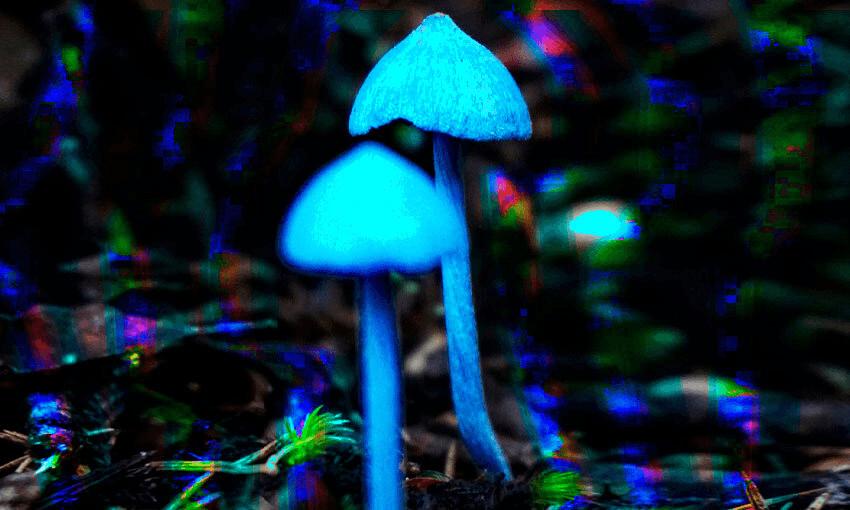Aotearoa’s very own werewere kōkako could be the secret to all-natural Powerade, blue jelly beans and even the elusive blue Froot Loop. Olivia Sisson speaks to a scientist trying to make it happen.
Blue food is having an absolute moment.
From the rise of blue spirulina smoothie bowls and blue rice to the resurgence of Blue Hawaii cocktails – eating aqua is in.
A few months ago @shityoushouldcareabout brought a blue food inequity to the fore: New Zealanders are missing out on blue Froot Loops. The American version of the cereal contains orange, green, purple and blue loops.
When asked about this discrepancy, Kellogg’s ANZ responded, “The reason you can’t find blue loops is because our Froot Loops don’t contain any artificial colours.”
According to Mashed, Kellogg’s adapted the product to suit markets, like ours, that prefer all natural. They use blackcurrants, carrots, spinach and nettle to produce purple, orange and green, but have been unable to sort a blue alternative.
Natural blue food dye is the holy grail of food chemistry. As scientist Silas Villas-Boas explains, the molecules that produce the hue are extremely sensitive to oxygen and quickly fade to brown. Dye derived from blueberries, for example, just doesn’t hold its vibrancy like synthetic blues do.
Villas-Boas, originally from Brazil, moved to New Zealand in 2004 to work as a post-doctoral researcher at AgResearch Ltd. That’s when he first learned about Entoloma hochstetteri – our national fungus. According to Manaaki Whenua, “The story of Tūhoe is that the North Island kōkako gets its blue wattle by rubbing its cheek against the mushroom – hence its Māori name werewere-kōkako.”
Werewere kōkako is as striking as it is elusive. “I had seen it on the $50 bill and I knew that the food industry had a big interest in natural blue colours. I also knew that there hadn’t been much study done on Entoloma’s pigment. But it’s not so easy to find them,” Villas-Boas says. Several years passed before he spotted one.
“I was in Porirua, I was on this track, and… there it was. I wasn’t even looking for it. It was very emotional. It’s just overwhelming when you see Entoloma in nature. It’s so brilliant, it almost looks alien.”
After his initial discovery, Villas-Boas set out to grow Entoloma in the lab, in order to investigate its unusually long-lasting blue shade. His research team got permission from the Department of Conservation to harvest 20 specimens per year. One year they found just one.
“We tried everything we could to grow Entoloma in the lab. This failed. A multinational food company was very interested in supporting the research, but they wanted to check out the molecules first. We never had enough material to extract and send to them though.”
Villas-Boas has since moved to France for another research endeavour, but he’s still working with Entoloma. Rather than trying to grow it, he’s looking at using sequence independent heterologous expressions of biosynthetic secondary metabolite gene clusters. Woah.
Put simply, this technology might allow Villas-Boas to take the blue gene cluster from Entoloma and put it “into” a fungus species that can easily be grown at scale.
“If this method is successful, the natural blue’s main applications would be in beverages, soft drinks and lollies. The cosmetic industry is also really trying to go away from synthetic dyes. There’s a real opportunity to build a very interesting story around this blue mushroom from New Zealand,” Villas-Boas says.
It’s not hard to see this unique product taking off. Just take Powerade. It currently gets its electric tinge from the synthetic colour E133, also called Brilliant Blue FCF, which has attracted controversy in the past. Entoloma Powerade, though? Totally natural, totally New Zealand. Imagine the Black Caps tipping that back during drinks breaks.
So what’s next for this research?
“We need an agreement to continue this research,” Villas-Boas says. “It requires genetic resources and you have to respect the ownership of genetic material. We need to reach an agreement that benefits both countries involved in the research and that also benefits Māori.”
“If we engineer a fungi that can produce Entoloma’s blue pigment, there will be a big financial benefit to whoever commercialises it. We’re looking for a partner in New Zealand now who can join us in the project and help us with the collaboration and benefit sharing elements.”
In short, New Zealand may hold the keys to the food dye of the future. With some investigation, investment and collaboration, the blue rabbit may finally be caught.

